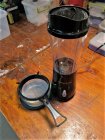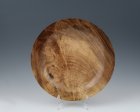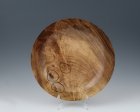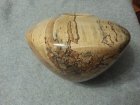odie
TOTW Team
- Joined
- Dec 22, 2006
- Messages
- 7,116
- Likes
- 9,818
It really chops it up with a mixture of sizes. That’s why I use the strainer to sift out the bigger particles. You can actually re-strain to yield and collect finer particles through a finer drywall sandpaper mesh. The blender’s glass container wall will be coated with the ultra fine dust which can be collected. The advantage of this process is you can make as much as you need at a consistent particle size. See the picture above.
I got the idea because I turned a burl and was wondering how to fill the voids. A friend said use coffee grinds. So I ground some coffee and tried it. It didn’t match. Then I got the idea to grind some of the burl’s bark in the coffee grinder. It worked but I quickly destroyed the grinder! I figured the blender would work because it does an excellent job on ice. A word of caution: ice is about 1.5 inch cubes. Use small pieces of bark/wood .5inch cubes. The Smaller the better and pulse rather than running the blender constant. Do not allow a heat build up inside the blender container. It’s possible that it could catch fire if you run the blender a long time. I empty the blender into the strainer often and reblended the bigger particles.
That's it!
This sounds like the perfect solution for me. Don't know why I've never heard of this before, but now I've got to try this out for myself. Matter of fact, I've got bowls in the shop right now that can use some help with small voids.
thanks
-----odie-----

I have used this inexpensive (about $10) blender a few times now, with mixed results. At this point, my opinion is that using sanding dust, or bandsaw dust is a better solution, but the blender still has value for large voids, or when other sources of a filler for epoxy isn't available.
The blender doesn't produce as fine a dust as sanding dust is. The bandsaw dust is slightly coarser than sanding dust. The blender takes shavings, and produces the coarsest particles of the three sources. All of these sources are definitely useful, but all have uses that are useful for specific tasks.
In the blender, the chips tend rise up, and stay above the cutter blade, and are not cut small enough for my purposes. The solution, here, is to use the blender momentarily......start/stop/start/stop/start/stop, etc. This allows the chips to fall back down below the level of the cutter, so they can be processed again. This works up to a point when there seems to be a limit on how small the pieces can be.
The blender is cheap, and useful......but, not quite the "magic bullet" solution I had envisioned. It's worthwhile to have one of these blenders on hand for those times where it's capabilities are best utilized.
(As I sit here and think about this, the thought of sharpening the cutter blade, or a replacement blade might improve the blender's utility.......I'll check into that.
-----odie-----



